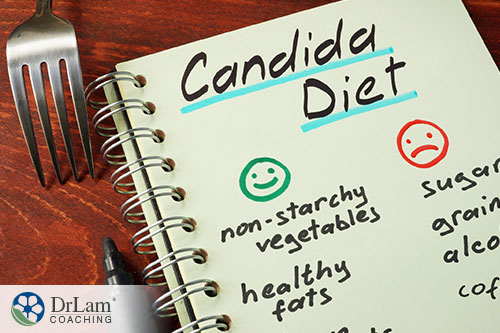 Everyone has Candida albicans, a fungus, present in and on their body. It is often responsible for infections in the body. That is why it's so important to understand what the Candida diet is all about.
Everyone has Candida albicans, a fungus, present in and on their body. It is often responsible for infections in the body. That is why it's so important to understand what the Candida diet is all about.
The majority of the time, the Candida fungus causes no problem at all. One of many organisms that live in your body, this fungus remains controlled by your immune system.
However, a suppressed immune system or broken mucosal barrier allows Candida to cause systemic infections. Increased growth of the Candida fungus comes as a result of the immune system not working well. Thus, if your immune system is not working at it's best, the candida diet could benefit you greatly.
You might think getting rid of all Candida fungus in your body would be the ideal solution. However, that isn’t true. In fact, using medicines that kill fungi may actually increase your chances of getting dramatic Candida infections later because the anti-fungal medication also kills off good bacteria in your gut. This weakens your body, including your immune system. This opens the way for the Candida fungus to come back stronger than ever.
The candida diet is a natural and safe way to avoid this weakening of your body while getting Candida fungus under control.
 Taking your time to deal with Candida is the best option. Following the candida diet for two months should allow your body to re-balance itself. The first month focuses on removing those foods that feed Candida. After this time, the second month allows you to slowly re-introduce foods one at a time to gauge their effects.
Taking your time to deal with Candida is the best option. Following the candida diet for two months should allow your body to re-balance itself. The first month focuses on removing those foods that feed Candida. After this time, the second month allows you to slowly re-introduce foods one at a time to gauge their effects.
Foods to avoid make up a fairly long list. A lot of foods serve to strengthen the growth of Candida, so they need to go out of your diet first.
However, it is still important to keep your nutrition and energy levels up during this Candida diet. Some of the foods you can eat include:
Start with low glycemic fruits on the first day. These fruits could include a small green apple, half of a grapefruit, or a small kiwi. Eat one serving three times on the first day.
On the second day, eat one serving of starchy vegetables. These include corn, potatoes, yams, or butternut squash. And do not eat the fruits you re-introduced the day before.
Next, add gluten-free whole grains like quinoa, millet, or brown rice.
For the first three days, watch for bloating, rash, diarrhea, constipation, fatigue, any pain, or sleeplessness. If you tolerate the newly added foods, go ahead and eat them. But If you don’t, simply avoid them completely.
Start re-introducing the other foods one at a time as above. You risk a relapse if you go back to using alcohol, sugars, gluten, or dairy.
 There are several herbs you can consider taking in addition to sticking with the Candida diet. These help boost the immune system and can be used directly on the affected area.
There are several herbs you can consider taking in addition to sticking with the Candida diet. These help boost the immune system and can be used directly on the affected area.
Once you start the candida diet you run the risk of what is called a "die-off" reaction. This occurs when the toxins released by Candida as it dies cause negative effects. Some of the symptoms of this "die-off" reaction include:
If you suffer from AFS, these symptoms may hit you harder. Your liver becomes overloaded with the release of these toxins. If your body is already congested, then the "die-off" may lead you into a crash. Be sure to check with an AFS specialist before embarking on the candida diet as it could make AFS worse. Finding the right time to deal with the candida in your body is very important to make sure that you can recover from the "die-off" symptoms.
Typically, the symptoms resolve within two to three weeks. You can begin taking molybdenum supplements that will convert the acetaldehyde byproduct into acetic acid which is harmless. Others also try taking anti-histamines to help with the itching.
Milk thistle is a great help in detoxifying your liver. It gives your liver the boost it needs to stay on top of the toxins released in the ‘die-off.’
Drink lots of water to flush out your kidneys. Your urine should be a pale yellow color.
Avoid stress. Rest and use gentle detoxifying methods like saunas or steam baths.
The Candida diet can be a great help in Adrenal Fatigue Syndrome (AFS). AFS results when your adrenal glands become fatigued from increased demand for cortisol. Stress from any source stimulates your adrenals to release cortisol to fight the effects of stress.
Chronic stress, the kind most often seen today, puts such a burden on your adrenals that they become unable to meet the demand. Thus, AFS symptoms begin.
The NeuroEndoMetabolic (NEM) Stress Response begins working when your adrenals become depleted. This response is an interrelated system of six circuits that work to help your body deal with stress. However, with chronic stress these circuits become dysfunctional.
 Inflammation is a natural response of your body to any infection. It serves to repair the damage caused by infection and to help rid your body of whatever caused the infection.
Inflammation is a natural response of your body to any infection. It serves to repair the damage caused by infection and to help rid your body of whatever caused the infection.
As soon as your body begins defending itself against those pathogens that cause infection, inflammation begins. Blood capillaries dilate to allow white blood cells access to the area of infection.
Fluids build up in the area of infection giving rise to the pain and swelling seen with inflammation. The molecules that fight the infection also contribute to the pain sensation.
Increased blood flow to the area of infection leads to the feeling of heat that comes with inflammation. Inflammation is a very beneficial response of your body that goes away once the infection is handled. However, with recurring infections, inflammation does not recede. It continues, often causing serious problems itself.
The inflammation circuit of the NEM stress response carries the burden of addressing Candida infections. Consisting of the immune system, the gut, and the microbiome, this circuit also reacts to the Candida diet.
With a Candida infection, your gut responds first. Dysbiosis of your gut sets in. This means the good and bad bacteria in your G.I. tract get out of balance. And one of the major problems that occur in this situation is a weakening of the barrier between your gut and the rest of the body.
This weakened barrier allows pathogens like Candida albicans and the toxins this fungus produces access to your bloodstream. Once this happens, the fungus and its toxins spread throughout your body.
This process stimulates your immune system into a hyperactive state because of the tremendous influx of toxins. In this state, your immune system over-reacts, misidentifies healthy cells of your body as invaders, and begins attacking them. This leads to autoimmune conditions.
When you go through the Candida diet, the resulting ‘die-off’ can bring about the same kind of conditions. The increased toxin load stimulates your immune system as well as clogging your liver.
Inflammation results from both situations. And chronic inflammation leads to multiple physical and psychological issues.
Also implicated in dysbiosis of your gut are the kinds of foods that feed Candida. Diets high in sugar and processed foods lead to both conditions: dysbiosis of the gut and Candida infections.
Thus a cycle is set in motion in which one condition feeds off the other in a downward spiral of serious health problems.
The antibiotics and antifungal medications typically used to deal with Candida infections also contribute to gut dysbiosis. They kill off the good bacteria in your gut as well as the bad. Thus, the resulting imbalance sets up your gut for dysbiosis and an overgrowth of Candida after the course of medications is over.
Adrenal fatigue appears to be a major trigger for dysbiosis of your gut. This condition weakens your body in general including your gut and your immune system.
One of the conditions it triggers is called ‘leaky gut’. This is a condition in which the normally tight junctions between epithelial cells which line your gut become looser.
Once this occurs, pathogens such as Candida can enter your bloodstream. The pathogens then become systemic, making them much harder to deal with.
Systemic infections also weaken your entire body, usually leading to an inability to digest foods properly and absorb nutrients effectively. This further weakens your body through malnutrition.
Both with AFS and systemic infections such as Candida, your body slows down. With advanced AFS, your body tries to conserve energy by slowing down processes. This includes the elimination of waste. Thus, constipation results. When this occurs, waste matter stays in your colon too long and allows yeast infections to proliferate.
Once again, inflammation grows as the infection spreads.
 Everyone harbors the Candida albicans fungus in and on their bodies. It causes no problems unless something allows the fungus to grow out of control.
Everyone harbors the Candida albicans fungus in and on their bodies. It causes no problems unless something allows the fungus to grow out of control.
If you do have an out of control Candida infection, it can become systemic, affecting all parts of your body. And at that point, it becomes very hard to eradicate.
Conventional healthcare professionals attempt remediation of this condition through courses of antibiotics and antifungal medications. These may lead to a higher risk of Candida infections over time. These medications kill good bacteria as well as bad, leaving the Candida fungus to regrow in a weakened gut system. This sets the stage for widespread infection.
With all infections comes inflammation to fight it. Systemic infections like Candida cause great increases in inflammation. If the inflammation gets out of control, it causes more problems.
In addition to ridding your body of Candida using natural substances or medications, you should consider the Candida diet. Over a two month period of time, you remove foods from your diet that feed Candida, such as sugar and fermented foods. For the first month, you eat foods that give you energy and keep your body functioning well. In the second month, you begin slowly reintroducing foods one at a time.
Doing this helps your body kill the Candida fungus. An issue that may arise is a ‘die-off’ response. This occurs when the toxins released by the dying Candida trigger symptoms themselves. Typically, these symptoms resolve in two to three weeks normally. There are also some things you can do to ease the symptoms that occur.
© Copyright 2021 Michael Lam, M.D. All Rights Reserved.
By following the candida diet, you first remove all those foods that feed the fungus and clear it from your body. Then, you add back foods one at a time to see how you handle them. This process requires two months to complete.
